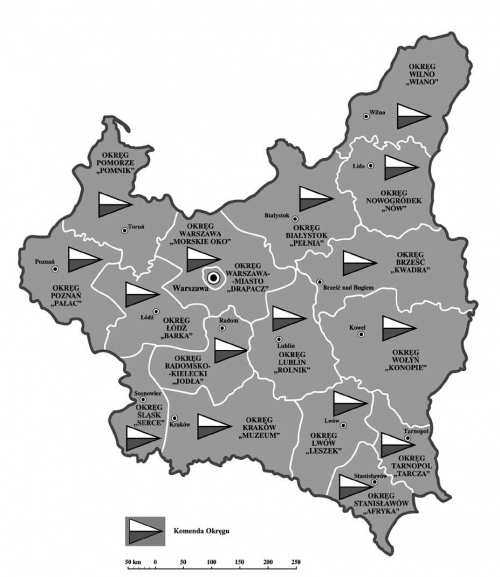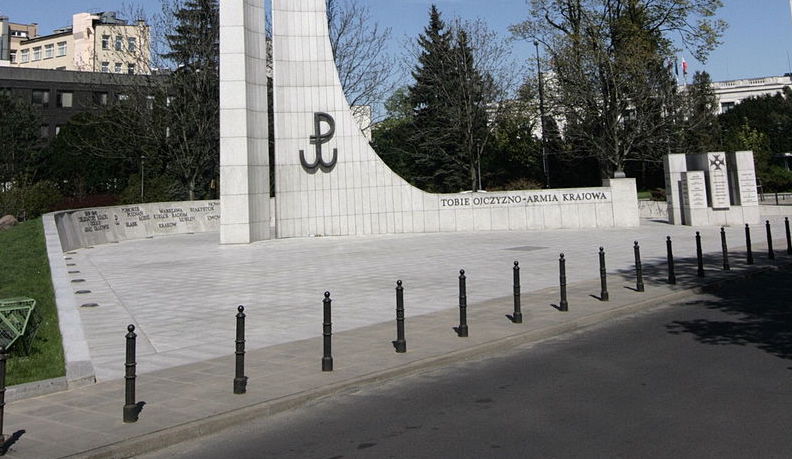On 14 February 1942, a cable was sent from London to Warsaw which stated the decisions of General Władysław Sikorski, the Commander-in-Chief and the Prime Minister of the Republic of Poland.
Its most important provisions were as follows:
“1) I abolish for external use the name ZWZ. All the soldiers of active military service in the Home make the Home Army” [...]
2) The General’s post is called the Commander of the Home Army.”
Pursuant to this decision, the Union of Armed Struggle (ZWZ, from the Polish Związek Walki Zbrojnej) was renamed the Home Army (AK, from the Polish Armia Krajowa) after two years of its operation. General Stefan Rowecki, the existing ZWZ Commander, became its head as the Commander of the Home Army.
The Union of Armed Struggle
The Union of Armed Struggle formed in November 1939 by General W. Sikorski was a part of the Polish Armed Forces. Initially, it was led by General Kazimierz Sosnkowski (until June 1940). The principles of the national conspiracy were developed by the Committee of Ministers for National Affairs (Polish Komitet Ministrów dla Spraw Kraju), which was also formed in November 1939. At first, the Committee was also led by General K. Sosnkowski, but he was later replaced by Professor Stanisław Kot.
In occupied Poland, the ZWZ took over the structures of the Service for Poland’s Victory (SZP from Polish Służba Zwycięstwu Polski), a military and civil conspiracy organisation formed on the day before the surrender of Warsaw.
Six regional commands were organised for the following areas:
No. 1 — Warsaw (code name: “Mag” (Magician))
No. 2 — Białystok (code name: “Rycerz” (Knight))
No. 3 — Lviv (code name: “Husarz” (Hussar))
No. 4 — Cracow (code name: “Giermek” (Esquire))
No. 5 — Poznań (code name: “Czarodziej” (Wizard))
No. 6 — Toruń (code name: “Prorok” (Prophet))
The main objectives of the activities undertaken by the ZWZ were defined as follows at the beginning of December 1939:
“a) through concentration of individuals selected after rigorous procedure in conspiracy structures — to create centres of active national resistance which should prevent the collapse of the moral power of Polish society
b) to cooperate in rebuilding the Polish state through military struggle. After the Polish Army enters the Homeland, the organisation shall be dissolved and incorporated into the regular forces.”
In January 1940, General K. Sosnkowski made changes to the organisation of the ZWZ in the Homeland as he established command for Polish forces in both the German- and Soviet-occupied areas of Poland. Command for Polish forces in German-occupied Poland, headquartered in Warsaw, was headed by General S. Rowecki, while the Commander of the SZP, i.e. General Michał Karaszewicz-Tokarzewski, was to head Command for Polish forces in Soviet-occupied Poland, headquartered in Lviv. As a result of numerous arrests made by the NKVD in Soviet-occupied territory, the establishment of command for Polish forces in this part of the country was essentially unsuccessful. The activities of the ZWZ (the Home Army) in the Eastern Borderlands of the Second Polish Republic were carried under orders from local (Lviv, Białystok) and regional (voivodeship) command.
The structure of the Home Army
The defeat of France in June 1940 resulted in General Stefan Rowecki’s appointment as ZWZ Commander (and then Commander of the Home Army). He was arrested three years later and was succeeded by General Tadeusz Komorowski (code-name: Bór), who — after his surrender to the Germans after the conclusion of the Warsaw Uprising — was succeeded by General Leopold Okulicki, the last Commander of the Home Army. He served in this role until 19 January 1945.
The ZWZ-AK’s High Command comprised several Divisions:
Section I: Organisation
Section II: Intelligence
Section III: Operations
Section IV: Logistics
Section V: Communication
Section VI: Bureau of Information and Propaganda
Section VII: Bureau of Finances and Control.
The intelligence activities of the Home Army were of international importance. More than 40 percent of the information obtained by the British intelligence service from the areas occupied by the Germans was provided by Polish couriers from the Home Army. Reports on German and Soviet (from June 1941) armed forced were sent from Poland to London. In addition to the movements of the enemy forces within Polish territory, the submitted information also included data concerning the activities on other fronts, which was also extremely important. This was a source of both information relating to and parts of secret German weapons, including the V-1 and V-2 guided ballistic missiles.
Another extremely important part of the activities undertaken by the Home Army was the Bureau of Information and Propaganda with developed structures that collected information, as well as the Secret Military Publishing Houses (Polish — Tajne Wojskowe Zakłady Wydawnicze). Also of note — Operation N consisted of sabotage activities carried out against German forces in the form of German-language press publications filled with false and misleading information.
The structure of the Home Army was divided into Areas (Obszar), Circuits (Okręg) (covering the area of a given voivodeship), Inspectorates (Inspektorat), Counties (Obwód) (covering the area of a poviat), Districts (Rejon) and Communities (gmina). There were the following Circuits: Warsaw-city, Warsaw-voivodeship, Kielce-Radom, Cracow, Lublin, Lviv, Stanisławów, Tarnopol, Volhynia, Polesie, Novogrudok, Vilnius, Białystok, Pomerania, Poznań, Łódź, and Silesia. These were the Circuits functioning within the territory of the Second Polish Republic, but it should be remembered that there were also circuits, if only for a short time, in Hungary and Berlin.
A very intensive consolidation policy was implemented with the involvement of different types of conspiracy organisations. In the years 1940-1944, this operation — ordered by the Commander-in-Chief — was participated in by at least 20 conspiracy organisations. These included the People’s Guard of the Polish Socialist Party — Freedom, Equality, Independence (Polish — Gwardia Ludowa Polskiej Partii Socjalistycznej - Wolność, Równość, Niepodległość, Gwardia Ludowa PPS-WRN), the National Military Organisation (Polish — Narodowa Organizacja Wojskowa), the Peasants Battalions (Polish — Bataliony Chłopskie), as well as a part of the National Armed Forces (Polish Narodowe Siły Zbrojne), and more.
The groups of the Home Army
In addition to the territorial structure of the ZWZ-AK, there were also specialised groups established within it. One of these was the Association of Retaliation (Polish - Związek Odwetu) which was formed from 1940 onwards, and then the Directorate of Diversion (Kedyw, from the Polish Kierownictwo Dywersji). The aim of this group was to carry out ongoing sabotage and combat operations: attacking communication routes, carrying out executions of Germans and their collaborators. The activities of these groups extended to areas outside the Polish state. Bomb attacks in Berlin and Wrocław carried out by the soldiers of the Home Army resounded throughout occupied Europe.
Another group was “Wachlarz” (Folding Fan) established in 1941, and it was tasked with creating a barrier to separate the country from the East.
There were also the Western Corps or the Silesian Legion, i.e. groups established to fight in western Poland. These groups were to be supported by, among others, the units of the Military Services for the Protection of the Uprising (WSOP, from the Polish Wojskowa Służba Ochrony Powstania). They were the military and police units established from January 1941.
Preparing to fight and recapture the Homeland
The main task of the Polish Underground State was to prepare and carry out a victorious general uprising. The majority of the activities performed by the Home Army and civil structures were aimed at the fulfilment of this mission. The first plan for a general uprising was developed in the second half of 1940. It was to start upon the fall of German power. The second plan was sent to the government of the Republic of Poland in London on 8 September 1942. Most of the territory of the Republic of Poland was prepared at the level of counties; the plans for “taking control of the area” were prepared with detailed assignments of tasks to individual units. In compliance with the plans for the uprising, the Reconstruction of the Armed Forces in the Homeland (Polish Odtwarzanie Sił Zbrojnych w Kraju) was prepared. It was used by fighting structures of the Home Army to take over the organisation of pre-war battalions, regiments and divisions. In addition, preparations also included the reconstruction of all services (logistics, communication, justice, etc.).
Political complications, especially after the discovery of the Katyń Massacre and the resulting break of Soviet-Polish diplomatic relations, caused a change in the prepared plans. In October 1943, the plan of the general uprising was replaced with a plan for intensified sabotage operations under the codename Tempest. The operation took place in stages, within the areas of individual Circuits of the Home Army in advance of the approaching Red Army. The units of the Home Army fought for Vilnius and Lviv together with the Red Army. The feats of the 27th Volhynian Infantry Division of the Home Army became legend. Those Units of the Home Army fighting in the Easter Borderlands of the Second Polish Republic in summer 1944 were later joined by others.
***
The Union of Armed Struggle had 40,000 soldiers in September 1940, while in spring 1944, the Home Army had 8,920 platoons and approximately and the number of its soldiers is estimated to be about 380,000. The losses of the Home Army are estimated at about 60,000 soldiers (15.79%). What is interesting is that in July 1944, the Staff of the Commander-in-Chief estimated that Polish forces in the Homeland numbered 9,000 officers and 150,000 non-officers (taking into account men of conscription age). They were to form three infantry divisions, 10 territorial divisions and 10 tank battalions.
Author: Waldemar Grabowski


